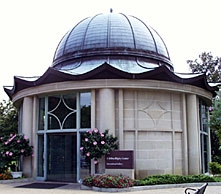In his talk, John Greenwalt Lee (Materials Conservator, The John Greenwalt Lee Company) focused on the importance of context and clear, effective communication in architectural preservation projects. Architectural preservation is a highly collaborative process involving multiple teams and stakeholders each having specific goals.
This requires a sophisticated level of communication for the effective execution of conservation and preservation, but also allows for a heightened level of collaborative interaction between conservator, contractor, client and community.
“Information is not valuable unless it is in context,” is a core principal for the firm and the presentation provided various examples illustrating the misunderstandings and assumptions that can arise from a lack of contextual information. In one example, a piece of crown molding was misunderstood as a convex architectural element, which complicated its re-integration into the building. The misunderstanding stemmed from a photograph of the object in which the molding was separate from the building and placed upside-down. Once the molding was considered alongside the building design, however, it became clear that the only possible incorporation of the element was as a concave architectural decoration. This aided an accurate re-integration into the building network.
In order to effectively convey vital information and supply necessary context to clients, the John Greenwalt Lee Company has developed several innovative practices that are focused online. Firstly, they organize reports in order to ensure crucial contextual connections between text, photographs, and floor-plans are easily made. They also focus on making information easily accessible for all invested stakeholders. Reports and high resolution images are available through a closed online platform (essentially a blog) to board members and contractors throughout the design and construction phase. The presentation emphasized that it was important that reporting was not considered a singular event, but an on-going process to make sure that all information is up-to-date, and that the reports are retained for future augmentation. This is particularly necessary for buildings since they are dynamic structures that go on living after conservation has been completed. It is also an excellent solution for dealing with such a large volume of documentation—having all documentation online allows it to be centrally located and readily accessible.
Furthermore, all relevant site information, such as specs, permits and lists of personnel are made available online. The result is that clients can verify that correct personnel are present and correct actions are being taken at any step of a process. Also, this provides the contractors with the means to understand why they are being asked by conservators to perform certain actions in a certain way, or to use some materials over others.
Beyond the cutting of communication channels among those involved in preservation of historic buildings, this online format offers helpful tools to clients for fundraising and outreach for donors. Past reports, images and resource videos posted to the blog can be easily referenced by clients when wanting to advocate for funding, or clarify what steps were being taken and the motivation behind them. It makes the use of taxpayer money more transparent, and provides a locus for board members and the public alike to examine and understand past mistakes in order to come to terms with how to best proceed in the future. Furthermore, it lends to the re-education and revitalization of not just the historic sites themselves but the larger communities to which they belong.
Summarized by Desirae Peters, 4th year Graduate Intern at the Smithsonian American Art Museum and Quinn Ferris, 4th year Graduate Intern at the University of Virginia Library and Special Collection
